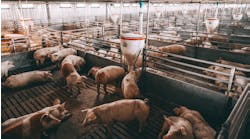Who hasn't experienced sticker shock when filling up their gas tank at their favorite service station? I would venture to guess most of us have gone through the initial shock of gas prices above $3 per gallon and now feel like we have gotten a bargain whenever we find prices below the $3 mark.
Television news and newspapers across the country tell us about our dependence on foreign oil and the many initiatives taking place to reduce our reliance on this unstable source of energy. Hybrid automobiles, ethanol and other fuel sources are just a few alternatives being debated in the national press.
So what does all this talk about gas prices have to do with food? According to the 2007 Survey of U.S. Food and Beverage Companies, commissioned by Grant Thornton and sponsored by Food Processing, rising costs are the number one threat to profitability noted by survey respondents. Further, transportation and energy costs were cited as the most significant component of these rising costs.
The survey revealed more than 80 percent of food and beverage firms experienced logistics/transportation and energy cost increases last year. Nearly 50 percent of respondents indicated these costs increased more than 5 percent -- and the survey was taken in late 2006, before gas passed the $3-a-gallon mark.
Obviously, the increase in transportation and energy costs has a direct impact on food and beverage companies and is a significant concern for the latter half of 2007 and beyond. But what about the indirect impact of rising fuel prices?
Rising fuel prices have had a tremendous impact on food and beverage companies far beyond the direct costs of transportation and energy. For example, there has been renewed interest in ethanol fuel in our country, which in the U.S. comes largely from feed crops such as corn. This diversion of corn from the ordinary uses in the market has caused corn prices to rise as much as 50 percent in some areas of the country.
Corn is purchased as feed for chickens and cows, which leads to higher meat and dairy prices in both grocery stores and in restaurants. Watch food producers reliant on feed and dairy ingredients cringe when you ask about their forecasted earnings. And on and on it goes.
This domino effect in the food chain impacts the price of almost every item produced and sold by food and beverage companies. It's truly amazing how $3-per-gallon gas sends shock waves through our economy.
Is there hope? Of course. Leading food and beverage companies are more innovative in controlling all types of costs incurred in their business. They are using technology and automation in new and exciting ways to reduce labor, lower back office costs and even to "go green."
However, the 2007 Survey of U.S. Food and Beverage Companies notes many companies do not have good visibility into how and where they spend their money. "Many companies could achieve significant cost savings by simply conducting a procurement audit of their spending," notes Steve Lyman, a partner in Grant Thornton's Advisory Services practice. "With this type of audit, they could determine whether they are using the most competitive suppliers and paying the most competitive prices," Lyman says.
The survey results indicate about two-thirds of the respondents expect transportation and energy costs to continue to increase during the next 12 months. The survey also notes most respondents expect labor costs, healthcare and the cost of capital to increase in the coming year. With these rising costs, it is imperative, like never before, that food and beverage companies understand and proactively address the total impact of these market conditions on their cost structures.
Dexter Manning is the national food and beverage industry leader for Grant Thornton LLP. He may be reached at 866-728-5264 or e-mail [email protected]. To request a copy of the 2007 Survey of U.S. Food and Beverage Companies, go to www.foodprocessing.com/gt/knowledge/index.html.

